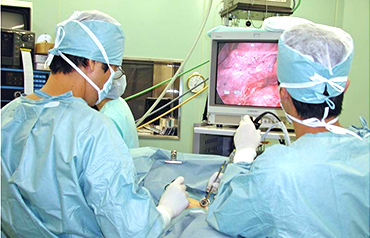Pulmonary Disease Center (Respiratory Diseases)
Overview
In recent years, lung cancer has consistently occupied the number one position in men for malignant tumors, the top cause of mortality in Japan, and it continues to show an increasing trend in both men and women. In addition to lung cancer, responses to other chronic respiratory diseases related to various environmental factors, such as chronic obstructive pulmonary disease (COPD), and bronchial asthma have been gaining in importance. This situation has led to the creation of the Sanno Hospital Pulmonary Disease Center, with Dr. Tetsuya Okunaka as Center Head, in partnership with the Respiratory Diseases Center of the International University of Health and Welfare Health, Mita Hospital.
For respiratory diseases, we practice team medical care with the internal medicine and surgery departments as well as the respiratory rehabilitation team joining forces to bolster our responses to bronchial asthma, pneumonia, COPD, and interstitial pneumonia, etc., under the leadership of Prof. Taiji Nagata of IUHW.
Conditions treated at the Pulmonary Disease Center
We diagnose and treat lung cancer and all other respiratory diseases, including bronchial asthma, chronic bronchitis, COPD, interstitial pneumonia, respiratory failure, pneumonia, mediastinal tumor, pleural tumor, pleurisy, and spontaneous pneumothorax. At the Center, we employ a wide range of diagnostic methods for patients of these diseases, including bronchoscopy, transbronchial lung biopsy, and core needle biopsy, along with lung cancer diagnosis with the use of a 64 channel multislice CT that does not miss even micro cancer, sputum cytology and tests of various respiratory functions.
Treatment at the Pulmonary Disease Center
We provide finely-tuned care in treatment by fully taking into account the conditions of individual patients, let alone medication and a variety of surgeries of respiratory organs. Beginning treatment with the smallest possible surgical wounds with less burdens on patients, we proactively practice thoracoscopic surgeries that can mitigate postoperative pain and shorten the hospital stay. In a thoracoscopic surgery, an operation is conducted with a tiny camera with a diameter of around 1cm inserted from a small incision with a diameter of about 2cm in the chest, to monitor the conditions inside the thoracic cavity. Instruments are inserted from other incisions to resect the affected areas of the lung or the lung lobe. There are many advantages in these surgeries, as small surgical wounds help reduce postoperative pain and an early recovery from surgeries shorten the hospital stay (the average hospital days: 6.3 days for lung cancer and 4.2 days for others).
At the Center, we also put emphasis on hospital care of aspiration pneumonitis and COPD, domiciliary oxygen therapy, and respiratory rehabilitation.
Achievements in Test and Treatment at the Pulmonary Disease Center

Dr. Okunaka has gained experience in more than 3,000 respiratory surgical procedures. He is actively engaged in the development of new diagnostic and treatment techniques, and his track record in laser treatment for lung cancer is well known the world over. The number of respiratory surgeries conducted at Sanno Hospital now stands at over 200, with roughly 70% done by thoracoscopic surgeries. The number of cases of either blood transfusion or surgery-related death in lung cancer surgeries has been zero, and the average stay in hospital is 6.5 days. In 2012, there were a total of 480 cases of chemotherapy (anti-cancer drugs), and depending on the conditions of patients, they were done either at an outpatient clinic or during several days' hospital stay. Our work on lung cancer is consistent and comprehensive, ranging from diagnosis and treatment to palliative therapy for recurring cases.